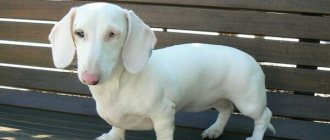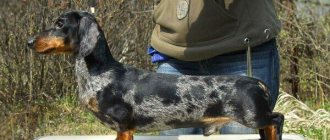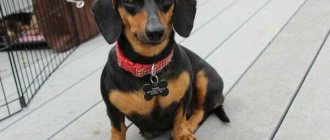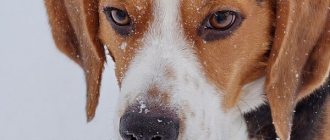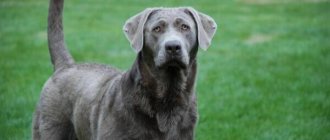The Russian Toy Terrier dog breed has gained particular popularity in Russia. The dog is small, but this does not affect its quality as a guard. She is a completely fearless animal that can always warn her owner about danger and come to his defense.
This breed of small dogs seems to be a faithful friend of its owner and a kind of family member. Even if you don’t see the dog in person, from the photo the Russian Toy Terrier evokes only positive emotions.
The breed is so unpretentious that it does not even require special care. Due to the small size of the dog, it is usually considered a “pocket” dog, but it is worth dispelling all the myths.
After all, it is not uncommon for the Toy Terrier to serve as a guard along with larger breeds. Developed hearing helps her hear even the slightest rustle of an approaching object, and a strong voice, like a bell, can help the owner orient himself and react in time.
History of the Russian Toy Terrier breed
Smooth-haired Russian Toy Terrier
The ancestors of Russian Toys were English Toy Terriers, who gained fame as incomparable rat catchers. The first representatives of this venerable family appeared in Russia back in the era of Peter the Great, and by the middle of the 19th century, small but extremely playful dogs turned into the favorite pets of the domestic elite. Toy terriers lived in imperial residences, guarded the chambers of wealthy landowners, traveling to balls and social events with their arrogant mistresses.
With the advent of Soviet power, decorative dogs migrated to the category of “bourgeois excesses”. The new government gave preference to more useful breeds aimed at full-fledged service and protection, so for almost half a century, toy terriers remained in the shadows, gradually dying out and degenerating.
In the 50s, Soviet cynologist enthusiasts decided to revive the tribe of legendary salon dogs. But since there were no purebred representatives of the toy terrier family left in the USSR by that time, specialists had to work with animals without pedigrees and individuals taken by Soviet soldiers from Germany as war trophies. An additional difficulty was that the offspring obtained during the experiment could not be compared with the cubs of English terriers due to the Iron Curtain policy. As a result, domestic experts did not suspect for a long time that they had bred a new breed, significantly different from the one they were initially targeting. For example, toy terriers of the Soviet “spill” were one and a half times smaller than their British counterparts, had different body proportions and skull shape.
Longhaired Russian Toy Terrier
However, the discoveries did not end there. In 1957, in a family of Russian Toys, where one of the parents was not purebred, a male puppy was born with long feathering of fur in the area of the ears and paws. The animal looked so cute and funny that the breeders decided to keep this attractive mutation, leaving the puppy for the breed. This is how an independent branch of the breed appeared - the Moscow Longhaired Toy Terrier.
Despite their sharply increased popularity, Russian Toy Terriers remained “local” pets for quite a long time, practically unknown outside the country. And only in 2006, the International Canine Association, reluctantly and with reservations, recognized salon dogs as an independent breed. At the request of the FCI commission, Russian Toy Terriers were renamed Russian Toys and received the right to participate in world and European championships.
An interesting fact: among the famous owners of these “toy” dogs are Alla Pugacheva, Garik Kharlamov, Sergey Lazarev, Christina Aguilera and Diana Gurtskaya.
Appearance of the Russian Toy Terrier
Russian Toys are small dogs weighing up to 3 kg. The average height of an individual is 20-28 cm, but often so-called mini-animals are born, whose height may be several centimeters lower than allowed by the standard. Despite such miniature parameters, Russian Toy Terriers look very elegant, which is partly due to their thin skeleton and lean muscles.
Head
Russian Toy puppy
The skull is small, but at the same time high and moderately wide. The cheekbones are flattened and slightly pronounced. The muzzle is dry, pointed. The transition from the forehead to the muzzle is clearly “drawn”. The lips are black and thin. The nose is medium-sized, black, or to match the main color of the animal.
Jaws
The Russian Toy Terrier has a scissor bite and small white teeth. The absence of several incisor teeth is allowed (two incisors for each jaw).
Eyes
Round, large, slightly convex. The landing is straight. The distance between the eyes is wide. The shade of the iris may vary.
Ears
The ears of a toy terrier are large and thin at the same time. Standing. Standing tall.
Neck
Slightly curved, long. Set high.
The muzzle of a Russian toy
Body
The back is strong and level with a smoothly descending top line from the withers to the tail. Body with a rounded croup. The abdomen is tucked, the lumbar region is short and convex. A selected groin makes the lower line of the body taut and curved. The chest is not wide, but deep.
Limbs
The front legs are straight, set parallel to each other. The muscles of the limbs are dry, the elbows look back. The length of the shoulders coincides with the length of the shoulder blades. The glenohumeral angle is 105°. The hind limbs are slender, straight (when viewed from behind), and set slightly wider in relation to the forelimbs. The muscles of the thighs are developed, but dry. The shins and thighs are the same length. The paws are small, oval-shaped, arched, and gather in a “lump.” The front legs are slightly wider than the hind legs. The pads are black, or repeat the main body color, and are elastic.
Tail
Exhibition Winner
In Toy Terriers, both docked and natural variants are allowed. The docked tail is usually short (recommended length - no more than 3 vertebrae), directed upward. The undocked one has the shape of a sickle or crescent, and is held at the level of the back, sometimes higher.
Wool
The characteristics of the coat directly depend on the type of individual. Shorthaired Russian Toy Terriers have a smoother coat that lies close to the body, characterized by an almost complete absence of undercoat.
In long-haired animals, the guard hair is longer, within 3-5 cm. The fur fits tightly to the skin in the body area. The hair has a slightly wavy or straight structure; the ears have a fringed coat. In adults, a flowing “fringe” hides the edges and tips of the ears. The back side of the limbs is decorated with so-called brushes. Soft, lush hair also grows in the paw area, covering the dog’s fingers and claws.
Color
Purebred individuals are distinguished by rich red, fawn, brown and black and tan, as well as lilac and blue and tan colors.
Rock defects
Disadvantages of the breed include any non-compliance with the standard of appearance. These are usually: excessively tall (above 28 cm), straight bite, semi-erect ears and a low-set tail. The presence of white markings on the paws and in the chest area, as well as monocolors (blue, brown, lilac, black) are not welcome.
The main disqualifying faults of Russian Toy Terriers
- The presence of bald spots in short-haired individuals, and the absence of fringed hair on the ears in long-haired individuals.
- Insufficient weight – less than 1 kg.
- Marble, spotted and white colors, as well as the presence of brindle markings.
- Aggression or cowardice.
- Short legs.
- Drop ears.
- Malocclusion.
- Absence of canines and more than 2 incisor teeth in each jaw.
Color
Previously, the only acceptable color was black and tan, and this continued until the mid-twentieth century. However, in the seventies, brown and red creatures began to be allowed into exhibitions, after which other original colors appeared. The skin of puppies is formed due to two pigments. This gives many different combinations.
The standard allows for the existence of all tan colors and any red shades. As a rule, tan marks are located above the eyes, on the chest, on the muzzle, and on the paws. They are also found under the ponytail, on the inside of the thighs. It is important that they are bright and clear.
The richer the better. Disadvantages include light marks on the chest and toes, large markings, and too dark markings. Dark, brown, blue color is also considered a disadvantage. White individuals, those who have such spots on the abdomen and on the head, are not allowed to compete. Large spots on the chest and neck are considered a disqualifying fault.
White
Unfortunately, such representatives of the breed are not allowed to compete. They do not participate in exhibitions and do not produce offspring that will someday receive an award.
However, they are very cute, their hair is soft and smooth to the touch. If you like such pets, you do not plan to win prizes, and perhaps you want to spay or neuter the dog, then why worry about whether the standard allows such colors? Feel free to have a baby like this!
You will have to take a little more care of this type of fur than standard fur, because it gets dirty quickly and needs to be cleaned more often. But this is not a big problem, because owners often prefer to walk their pets in clothes that prevent dirt from getting onto their fur coat.
To read: Charming white dwarf Pomeranian spitz: recommendations for caring for your pet
Ginger
Essentially, this is the same as fawn coloring. There are both light and bright variations of red skin.
Such dogs have an albinism gene, which makes the main pigments lighter.
This is one of the most common palettes; fiery terriers look very stylish, they are noticeable from afar, and stand out from others. It is desirable that the tone be very saturated; pale ones are also allowed, but are rated much lower.
Pearl
This is another name for cream color. More often, pearl babies appear in both light-colored parents, because the gene for this color is recessive.
Occasionally it happens that cream offspring are born from standard mothers and fathers who have hidden genes. These dogs have real aristocracy; they look attractive and elegant.
However, they need to be carefully looked after, because a light fur coat gets dirty faster and requires regular cleaning to maintain its aesthetics.
Sable
Sable dogs are those in which every hair is red on the roots and charcoal on the tips. As a rule, in childhood they are completely dark, but over time the hair at the roots lightens. If the baby was born already sable, you should be afraid that over the years he will become completely red. In some cases, the coal one remains only on the back or on the ears, and the fiery one dominates. This is a popular color, such terriers can be found everywhere, they correspond to the standard and are very popular.
Blue
Rare four-legged animals that look truly original. The same recessive gene is responsible for this fur coat color, which makes it less saturated.
It blurs the colors, as if brightening the skin. The gene initially went to a black kitten, it lightened its natural tone, and it was born gray-blue, and the brown one was born red-blue.
Such four-legged animals are called lilac ones. It seems that the fur of these animals is painted with watercolors, it looks so delicate and transparent. Let's say they have a tan. These are very expensive and valuable specimens; many people try to breed just such toys. They are slightly more expensive than standard ones.
Character of the Russian Toy Terrier
Russian Toy with owner
Russian Toy Terriers are pets that can dispel any blues. Active, affectionate and emotional, they are ready to frolic and play pranks all day long. These temperamental kids require a lot of attention and constant “feedback”, so when buying a Russian Toy, prepare for the fact that peace and solitude will forever disappear from your home as soon as the animal crosses its threshold. Representatives of this breed are completely non-aggressive, which does not in the least prevent them from being excellent watchmen, warning with their ringing bark about the arrival of an uninvited (and often invited) guest. Among breeders, Russian Toy Terriers are considered to be very smart and skilled manipulators. If the owner, smitten by the sweet appearance of the pet, gives up, there is no doubt: the animal will find a way to use this loyalty to its advantage.
The specific characteristics of the breed include the psycho-emotional instability of its representatives. Russian Toy Terriers easily get turned on by the slightest rustle and take a long time to calm down. As a rule, excitement is accompanied by increased activity of the animal and prolonged barking. Of the unusual talents of miniature dogs, their amazing memory abilities are of particular interest. In particular, Russian Toi are able to store in their memory events that happened three years ago. Often an animal can remember and identify a person it has met only once.
What do boys and girls look like and how do they differ?
Boy Toy Terriers look more presentable than girls . This is due to the fact that they do not have to go through pregnancy and childbirth, which is a blow to the appearance of females.
NOTE!
Males are slimmer and fitter, they are smaller than females, which is explained by physiology: the larger the female, the easier it is for her to bear offspring.
There are also differences in character. Girls are kinder and more sympathetic. They are obedient and calm.
An undoubted advantage is that they do not mark territory, unlike boys, but owners will have to deal with estrus , as well as childbirth and pregnancy .
Childbirth for such a small breed can be complicated, so sometimes specialist intervention is required.
Males, accordingly, are more aggressive. They become strongly attached to the owner, but obey him if they sense his advantage and alpha character.
Males are more difficult to train, but remember commands better.
Also, boys are more successful in exhibitions and competitions. This is also due to the fact that they do not have to take long breaks in order to bear and feed their offspring.
Education and training
There are no special methods for teaching basic commands for Russian Toy Terriers, so standard training techniques are used for them. However, these dogs do not perceive the authoritarian style of influence well. The animal gets scared, withdraws into itself, or, on the contrary, tries to be cunning, which negatively affects the formation of its character. In general, representatives of this breed are not the most diligent students, so you should not hope for lightning-fast success in mastering commands. Of course, with enough patience and perseverance, toys can be taught all the necessary skills, it will just take a little more time to achieve the final result than, for example, when training shepherds.
Puppies under the age of 6 months require especially reverent treatment: no matter how the pet annoys you with its pranks, punishment is not applied to it. If the puppy's poor performance during training causes irritation, it is better to postpone the training. However, you shouldn’t overindulge your pet’s whims either. As much as you might want to, don't let your dog sleep in your bed. Representatives of this breed have rather weak bones, for which even a simple jump from a bed can result in serious injury. And of course, don’t forget about the systematic rewards that help simplify the training process and quickly achieve your goals.
How to stop a Russian Toy Terrier from barking
Frantic barking is considered the main drawback of the breed. Toy terriers bark often and a lot, and the reasons for such “opera arias” can be the most insignificant. Do not try to calm an excited dog by stroking and gentle coaxing. A cunning pet will see this as encouragement and will try even harder. Painful techniques and surgical intervention are fraught with a negative impact on the already unstable psyche of the dog.
Usually barking is stopped with a command (“Ugh!”, “You can’t!”), pronounced in a stern tone. Sometimes the ban is accompanied by a light slap of the animal with a newspaper. In some cases, the ignoring method is used. When the dog starts barking, the owner deliberately distances himself and tries not to look at him. As a rule, not receiving outside support, they cancel the concert. The latter technique is considered alternative and energy-intensive, since it takes more time and nerves of the owner to develop the skill than when using a command technique. In addition, ignoring does not work in cases of older puppies that have not been raised before. Such animals are already accustomed to causing a commotion, so they are unlikely to monitor the owner’s behavior.
How to stop a Russian Toy from biting
From an excess of emotions, Russian toy terriers often bite their owners. Despite the fact that such injuries do not cause serious harm to health, you should not indulge your pet. You can wean your animal off a bad habit with a slight cry of “Ouch!”, signaling the infliction of pain. If the incident occurs during the game, stop the gameplay and leave your pet alone for a while so that he understands that he made a mistake. Do not hit the dog under any circumstances, this will only make things worse.
Russian toy terrier in winter clothes
Care and maintenance
Due to its charming appearance and tiny dimensions, the Russian Toy Terrier resembles a funny toy, which is difficult to perceive as a full-fledged adult animal. Regulars of Instagram and themed photo shoots, these dogs are increasingly turning into a fashion accessory and living advertisement of their owner. Manufacturers of clothing for dogs also add to the artificial excitement by making entire collections of outfits and shoes for toys. However, experienced breeders do not recommend getting too carried away with fashion shows. It is enough to purchase several insulated overalls for your pet for the autumn-winter season. But “packing” a living creature into tight dresses, and even more so, into boots, is clearly unnecessary.
Important: the characteristic trembling characteristic of representatives of the Russian Toy breed is not an indicator of hypothermia. Usually dogs tremble from excess emotions and overexcitement.
Hygiene
Don’t go to extremes and clean your pet’s ears every day. If there are no foreign objects or contaminants in the ear funnel, the hygienic procedure is carried out once a week, using boiled and cooled vegetable oil and a cotton pad, or cleaning lotion from a veterinary pharmacy. Once or twice a week, dogs have their teeth brushed with a special toothpaste or chalk powder with soda and lemon juice. Adult animals should have their nails trimmed once every 15-20 days. 10-day-old puppies also have their nail plates trimmed to prevent the cubs from injuring their mother.
The Russian Toy does not require the services of a breeder or daily brushing (with the exception of long-haired individuals). It is enough to regularly remove dirt from the coat with a cleaning mitten. Too frequent water treatments can dry out your pet's skin and cause bald spots, so experts recommend bathing Russian Toy Terriers once every six months. Puppies under 6 months of age are strictly prohibited from bathing.
Feeding
There are three options for feeding Russian toys: “natural”, “drying” and a mixed diet. In the first case, the animal’s daily “menu” should include meat (preferably beef), fermented milk products (no more than 3% fat), sea fish fillet, cereal products, egg yolk, vegetables and fruits. Each dog’s “meal” should consist of 1/3 animal protein (meat, fish) and 2/3 cereals, vegetables and dairy products. The volume of each serving is based on 50-80 grams per kilogram of dog weight.
From time to time it is useful to treat your pet with rye crackers and vegetable oil in the amount of 1 teaspoon per day. A couple of times a month they give a clove of garlic, which works as an anthelmintic. Bread, smoked meats, bones, exotic fruits, egg whites and river fish are strictly prohibited.
In the case of dry food, preference is given to varieties that contain at least three types of cereals, vegetables, fruits and at least three animal proteins. Options with soy, yeast additives, wheat and corn are best avoided. Adults are given food twice a day, combining it with a vitamin-mineral complex selected by a veterinarian.
Toilet
Russian toy terriers do not get used to the litter box right away, and sometimes they don’t get used to it at all, so often the only possible toilet option for a dog is a diaper (newspaper). Monitor your puppy closely during the first months of life. In particular, after sleeping, feeding and playing, be sure to put him in a diaper or in a tray to catch the moment when the baby is about to relieve himself. After each “puddle” made in the right place, the pet is supposed to be praised and treated. A fairly effective way is to place the dog in an enclosure with a tray, thus limiting its habitat. Usually the puppy quickly realizes that having a toilet next to his own bed is not a good idea, and uses the litter box.
Russian-toy
What to do to improve your life and increase its duration
To increase your pet's life expectancy, you must follow these recommendations:
- Watch your diet. It should be nutritious and balanced. It is advisable to purchase premium dry food.
- Do not feed the animal “from the table”. The food that a person eats is completely unhealthful for a small dog.
- Visit your veterinarian regularly for examinations, vaccinations and deworming. The observing veterinarian will select the necessary vaccine himself.
Owners should not forget about pet hygiene. A toy terrier needs to have its nails trimmed, its eyes and ears cleaned, and its fur combed out from time to time.
Proper nutrition is essential for a healthy dog
Health and diseases of the Russian Toy
The average Russian Toy Terrier lives from 10 to 15 years, although history has recorded cases where individual representatives of this genus lived to reach their 20th anniversary. The most common diseases of Russian Toys are cataracts, retinal atrophy, subluxation of the patella, and hydrocephalus. Pancreatitis is quite common, resulting from attempts to diversify a dog’s diet with pickles and fatty smoked meats.
Particular danger lies in the fragile thin bones and excessive mobility of the animal, so representatives of this breed are injured easily and often. Some individuals may have a genetic abnormality such as avascular necrosis of the femoral head. Usually the disease leads to lameness of the pet, and if left untreated, to complete atrophy of the hind limbs.
Photo gallery
Photo 1. Dog with long hair
Photo 2. Dog's head
Photo 3. Puppy playing
Photo 4. Toy terrier puppies
Photo 5. Two dogs of different colors
Photo 6. Mini toy terrier
How to choose a puppy
Choose an affectionate, easy-going animal at the age of 2.5, or preferably 3 months. During this period of life, the puppy's weight should be about 1.5 kg. If the dog weighs 600 g or less, most likely they are trying to sell you a defective dwarf dog. Try to get the most complete information about the puppy’s pedigree, even if you are going to purchase a Russian Toy Terrier of the pet category.
Reasons to be wary:
- the puppy is shown in a cage without being released from it;
- the animal's fur has bald spots;
- the dog has overly bulging eyes or slight squint, which is often a sign of increased intracranial pressure;
- there is discharge from the nose and eyes;
- the puppy does not have a veterinary passport.
Conditions for a pet weighing 1.5 kg
The Mini Toy Terrier requires special conditions so that it does not get injured or get stuck between pieces of furniture. The photo below clearly shows how small it is. Since dogs are inquisitive, it is necessary to isolate all wires from its curiosity; if the baby takes a bite, an electric shock can kill him.
It is advisable to cover slippery floor coverings with a carpet or a path; toys have long and thin legs, which can be injured if they slip. Arrange your sleeping place in a quiet place, not a walk-through place, away from heating devices; drafts are also contraindicated.
It should be soft, but do not use foam or feather pillows. It is necessary to clean and change the pillowcase to remove animal hair and smell. For playful pets, you can equip a mini play area.
Meals should be organized according to the following scheme:
- 3 months – about five feedings per day, in small portions;
- 5 months – three feedings;
- 6 months – two balanced meals a day is enough.
Photos of Russian Toy puppies
How much does a Russian Toy Terrier cost?
You can buy a Russian Toy Terrier puppy in nurseries for 20,000 – 50,000 rubles. Cheaper options can be found in the advertisements. In this case, the price of an animal with the RKF metric will be from 12,000 to 17,000 rubles. In addition, the cost is affected by the class, gender and color of the dog. Although the sexual type of Russian Toys is weakly expressed and the external characteristics of males and females are approximately the same, the latter will cost significantly more. Of the entire palette of colors, lilac-tan and blue-tan are considered the most scarce and, accordingly, expensive. The cheapest color option is red.


